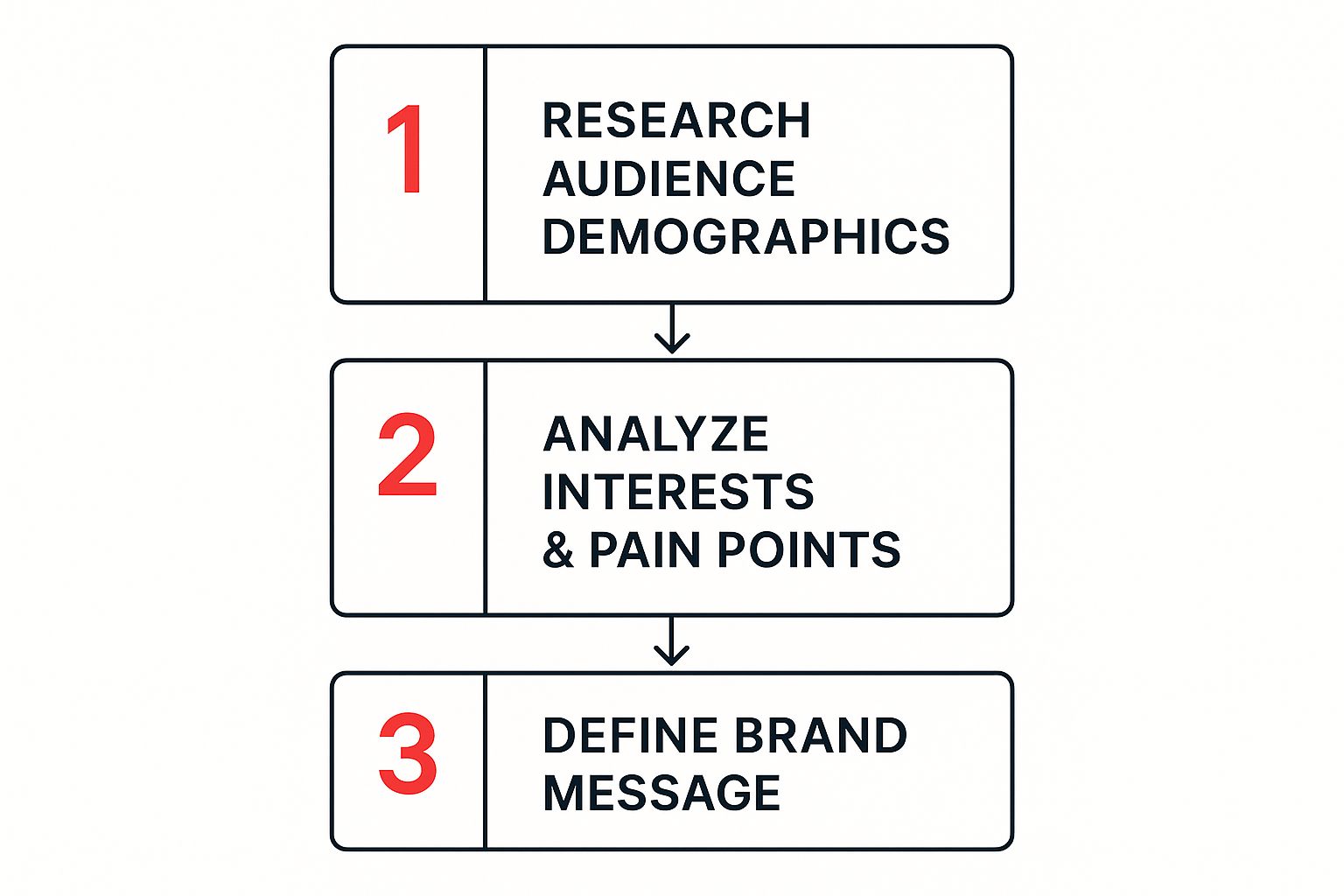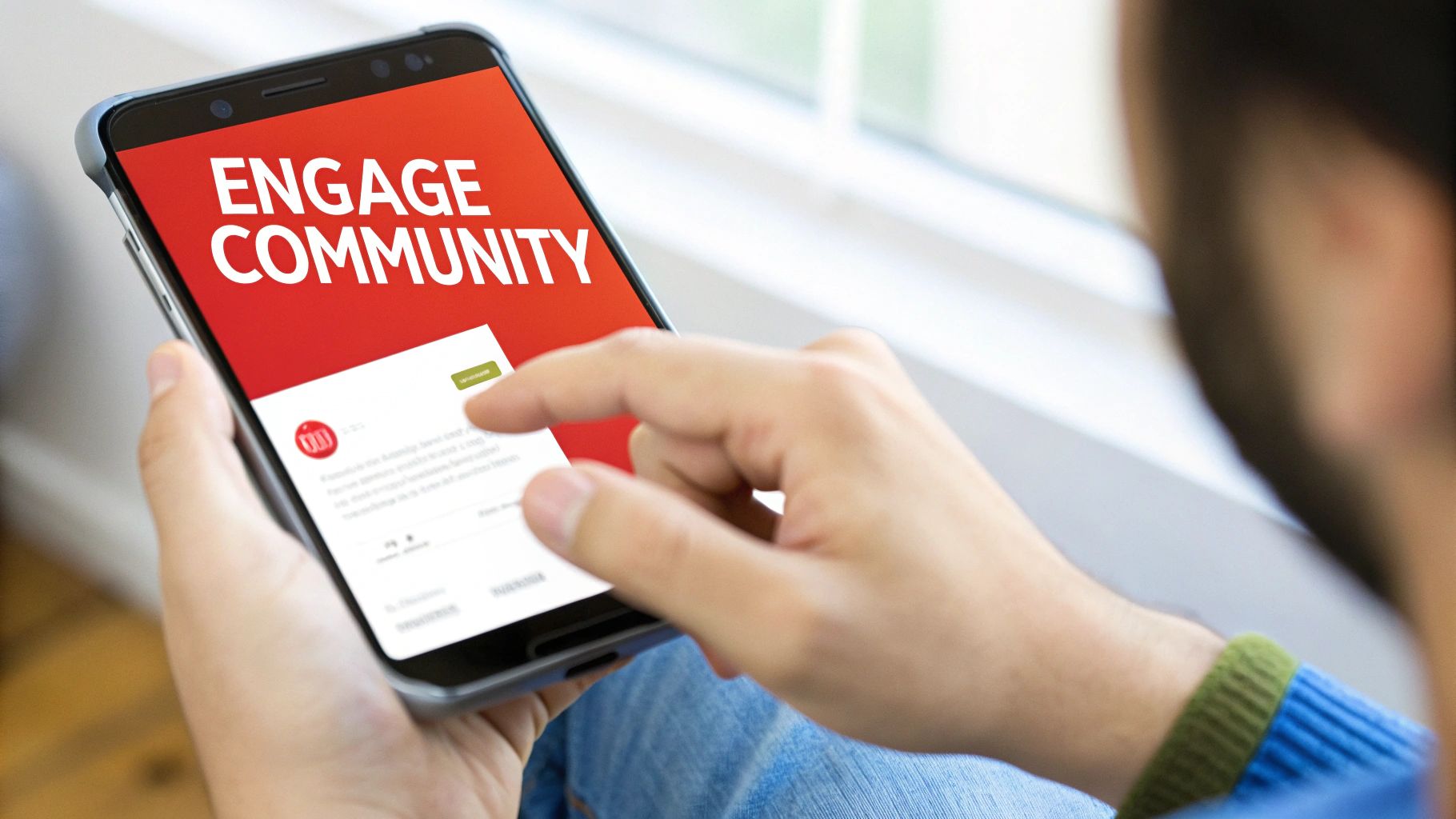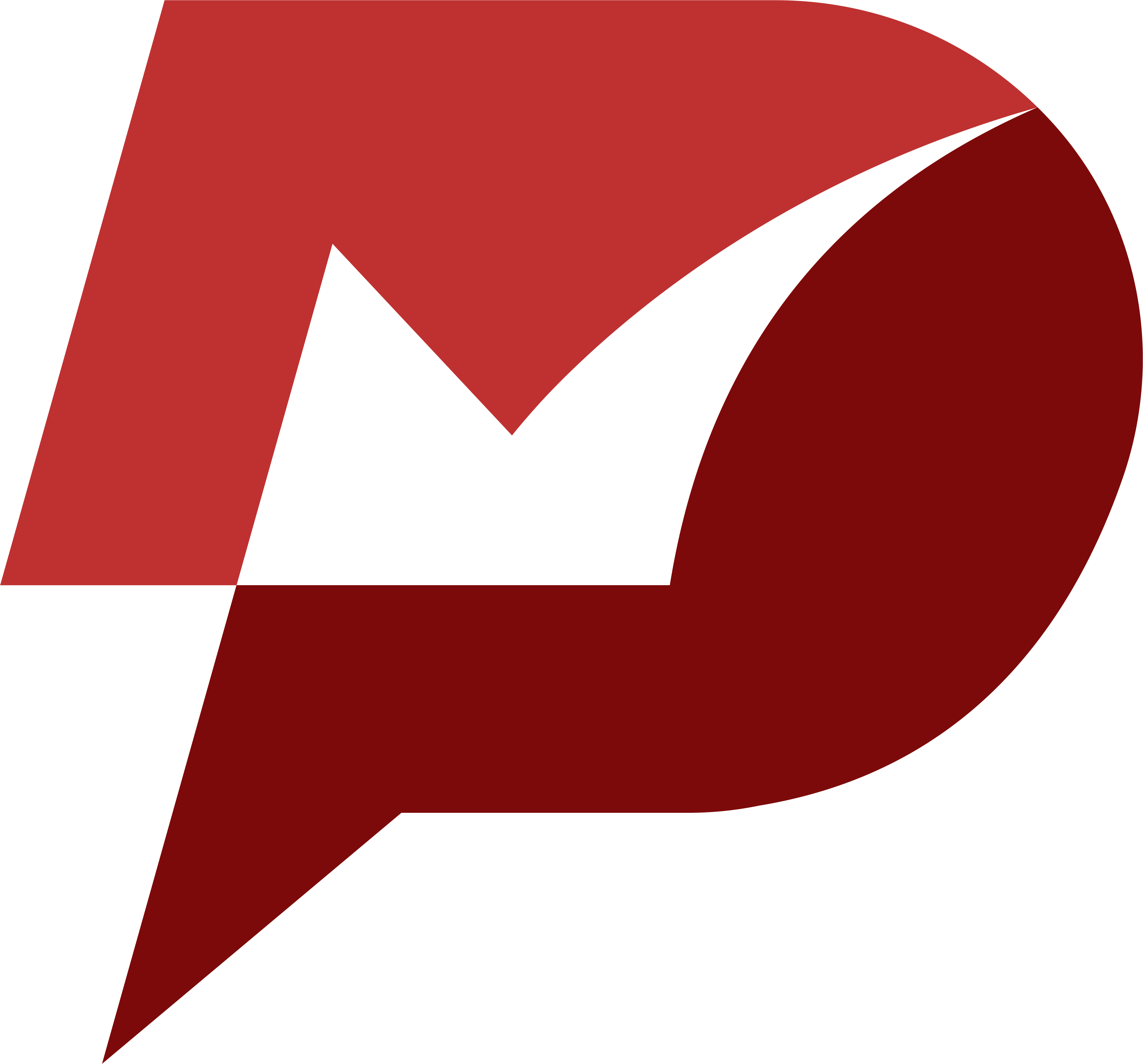So, what does it really mean to build a personal brand online? At its core, it's about finding your specific corner of the internet, consistently sharing things that people find valuable, and building a real community on a few key social media platforms.
It’s less about a formula and more about channeling your unique skills and personality into a digital identity that people trust. Get this right, and you'll find it opens up all kinds of doors for your career and business.
Why a Personal Brand Is Your Greatest Career Asset

Before we get into the nitty-gritty of how to build your brand, let's talk about why it's so important. A strong personal brand isn't just some fluffy marketing term; it’s your professional reputation in a world that’s always connected. Think of it as your digital handshake—it establishes your credibility long before you ever walk into a room or hop on a call.
A well-crafted brand pulls in opportunities you might not even know are out there. Imagine a software developer who shares helpful tips and maintains an active GitHub profile. They're far more likely to get noticed by recruiters for a dream job than someone with just a static resume. The same goes for a freelance graphic designer who consistently posts their best work on Instagram—they can attract high-paying clients from all over the world without sending a single cold email.
Turning Presence Into Opportunity
Your online brand is living proof of your passion and skills. It’s a dynamic portfolio that’s working for you 24/7, telling a story about your professional journey in a way that makes you far more memorable than a list of past jobs on a CV.
And this digital footprint has a very real impact. The numbers don't lie. A global survey found that 44% of employers have hired someone specifically because of their personal branding content. On the flip side, 54% rejected candidates because of what they found—or didn't find—on social media. This shows that your online presence directly influences almost half of all hiring decisions.
Your personal brand is what people say about you when you're not in the room. In the digital age, that room is the entire internet.
The Foundation of Modern Networking
Ultimately, building a personal brand is about making genuine connections and becoming the go-to person in your field. It's the bedrock of networking today and a crucial part of any serious social media branding guide.
The benefits are real and can seriously fast-track your career growth:
- Stand Out From the Crowd: A strong brand helps you get noticed by the right people in a sea of competition.
- Build Real Trust: When you consistently share your expertise, you build credibility with your audience.
- Grow Your Circle: Connect with peers, find mentors, and attract clients who can open up new opportunities.
- Tell Your Own Story: You get to shape your professional narrative instead of letting someone else define it for you.
Defining Your Unique Brand Identity
Once you’ve figured out why you're building a personal brand, it's time to lay the groundwork. This is where you shape the look, feel, and voice of your entire online presence, and frankly, it dictates everything you'll create from here on out. A strong brand identity is so much more than a slick logo or a cool color scheme—it’s about getting crystal clear on your purpose, who you’re serving, and what makes you the go-to person in your field.
Lots of people get hung up here. They hear advice like "just follow your passion," which sounds great but isn't always practical. Passion is a key ingredient, for sure, but it’s not the whole recipe. A more solid approach balances what you love with what people actually need and are willing to pay for. This way, your brand isn't just authentic to you; it's built to last.
Find Your Sweet Spot With Ikigai
A brilliant framework for this is the Japanese concept of Ikigai, which roughly translates to "a reason for being." It's about finding that sweet spot where four crucial parts of your life overlap, giving you a powerful and sustainable focus for your brand.
Imagine a Venn diagram with four circles:
- What You Love: What topics get you fired up? What could you talk about for hours without getting bored?
- What You're Good At: These are your hard-won skills and natural talents. What do people always ask you for help with?
- What the World Needs: Think about the problems you can solve for a specific group of people. What gap can you fill?
- What You Can Be Paid For: Which of your skills or knowledge has real market value? What will people happily pay for?
Your personal brand’s magic happens right in the middle, where all four of these circles meet. For instance, a video editor might love the art of filmmaking (love), be a wizard with Adobe Premiere Pro (good at), see that new creators are desperate for high-quality editing (world needs), and know they can charge for freelance services (paid for). That intersection is their niche. It's not just a job; it's their Ikigai.
To help you map this out for yourself, I've put together a little worksheet. Take some time to really think through these questions—your answers will become the blueprint for your entire brand.
Your Personal Brand Identity Blueprint
| Brand Component | Guiding Questions | Your Answer |
|---|---|---|
| Mission | Who do you help, and what transformation do you provide for them in one sentence? | |
| Core Values | What are the 3-5 non-negotiable principles that guide your work and decisions? | |
| Unique Selling Prop | What makes you different from everyone else in your space? What's your secret sauce? | |
| Brand Voice/Tone | How do you want to sound? (e.g., witty, authoritative, empathetic, playful) | |
| Target Audience | Describe your ideal follower or client in a few sentences. What are their biggest struggles? |
Filling this out gives you a tangible reference point you can always come back to. It keeps you grounded and ensures everything you do is aligned with your core identity.
Tell a Story People Will Remember
With your niche defined, it’s time to wrap it in a story. We’ve all heard it before: facts tell, stories sell. It’s a cliché for a reason. Your brand story is what turns your expertise from a dry list of facts into something that connects with people on a human level. It’s not your resume; it's the why behind what you do.
The most compelling brand stories often come from a place of struggle or a problem you personally solved. That vulnerability is what builds trust and makes you relatable. Are you a financial coach who clawed your way out of debt? A fitness influencer who overcame a major health scare? That journey—the messy middle part—is what makes your advice resonate.
Your brand story isn't just about your successes; it’s about the journey that gave you the wisdom you now share. Authenticity is your most powerful connector.
A big part of sharing this story effectively on platforms like LinkedIn is solid profile optimization, which helps you communicate your value proposition at a glance.
Know Exactly Who You're Talking To
Here's a hard truth: if you try to talk to everyone, you'll end up connecting with no one. A powerful brand is a specific one. You need to know exactly who you're creating content for. When you define your ideal audience, you can tailor your message, your tone, and your content to solve their specific problems.

As you can see, truly understanding your audience's pain points is the bridge between simply identifying them and crafting a message that genuinely helps. If you want to go deeper on this, our guide on https://monetizedprofiles.com/blogs/monetization-on-social-media/how-to-identify-target-audience walks you through the exact steps.
Finally, pull all of this work together into a sharp, clear mission statement. This isn't some formal paragraph for a business plan. It’s a simple, powerful sentence that declares who you help, how you help them, and the result they can expect.
For example: "I help aspiring freelance writers land their first high-paying client by teaching them practical pitching and negotiation skills."
This statement is your North Star. It’ll guide every tweet, video, and blog post you create, ensuring your brand stays focused, consistent, and on-point.
Choosing Your Platforms and Building Your Online Home

Okay, you've got your brand identity nailed down. Now for the big question: where do you actually set up shop online? The first impulse for most people is to sign up for everything and start blasting content everywhere. I've seen it time and time again, and it's a fast track to burnout.
The smarter play is to be strategic, not omnipresent. When you're just starting out, pour your energy into one or two platforms where your ideal audience is already spending their time. It's all about quality over quantity. Trust me, a deeply engaged community on one platform is a thousand times more valuable than a superficial presence on five.
Where Does Your Audience Live Online?
Your platform choice shouldn't be based on what you like, but on where your people are. Go back to that ideal audience you just defined. Where do they go to learn, to be inspired, or just to kill time?
If you're a career coach trying to reach young professionals, LinkedIn is a no-brainer. It's the digital water cooler for all things career-related. But if you’re a food blogger with stunning recipes, you’ll find a much warmer welcome on visually-driven platforms like Instagram or Pinterest.
Here's a quick rundown to get you started:
- LinkedIn: The undisputed champion for B2B pros, consultants, and anyone navigating the corporate world. It's built for thoughtful text posts, industry insights, and making professional connections.
- Instagram: A visual-first playground perfect for anyone in fitness, fashion, food, art, or travel. The magic happens in Reels, Stories, and beautiful, high-quality images.
- X (formerly Twitter): Your spot for real-time conversation. It's perfect for connecting with folks in tech, journalism, and marketing who thrive on short, punchy, and timely updates.
- YouTube: The king of video. This is where you go to build deep, lasting connections through tutorials, in-depth reviews, and personality-driven vlogs.
Take Instagram, for example. It’s still a powerhouse for brand building, with a staggering 2 billion monthly active users. It’s especially dominant with the 25-34 age group, a prime demographic for so many personal brands. Even with engagement rates shifting, it often outperforms other platforms, making it a fantastic choice if your content is visual. Diving into some recent social media insights can really help you see where these trends are heading.
Your Digital Real Estate: The Personal Website
Social media is amazing for getting discovered and starting conversations, but it has one massive flaw: you don't own it. Algorithms change on a whim, platforms fall out of fashion, and accounts can get shut down with little warning. This is precisely why you need a home base that you actually control.
Your personal website is your digital real estate. It’s the one corner of the internet that is 100% yours. This is where you anchor your brand, showcase your best work, and build a direct line to your audience through an email list—no algorithm in sight.
Think of social media as rented land where you set up outposts to meet new people. Your website is the land you own, where you build your forever home and invite your true community to gather.
This home base is critical. It acts as a central hub for everything you create, gives you a professional place to offer your services, and instantly boosts your credibility. When someone Googles your name, you want your website to be the first thing they see. You control that first impression.
Aligning Platform and Content Style
Finally, the platforms you choose have to vibe with the kind of content you actually enjoy making. If you dread being on camera, committing to a daily YouTube vlog is a recipe for misery. If you’re a fantastic writer who loves diving deep into a topic, then a blog promoted on LinkedIn or X is a much more natural fit.
Try this simple matching exercise:
| If Your Strength Is... | Consider Platforms Like... |
|---|---|
| Writing & In-Depth Analysis | Blog, LinkedIn, Medium, X |
| Visual Storytelling & Aesthetics | Instagram, Pinterest, YouTube |
| Short-Form Video & Personality | TikTok, Instagram Reels, YouTube Shorts |
| Building Professional Networks | LinkedIn, Industry-Specific Forums |
Choosing the right platforms isn't about chasing the next shiny object. It's a calculated decision based on your audience, your goals, and what you can realistically create week after week. Start small, get really good at one channel, and only then should you thoughtfully expand.
Creating Content That Builds Real Authority
https://www.youtube.com/embed/4ZS8dMwPObk
Now that you’ve picked your platforms, the real work begins. Your content is the engine that drives your personal brand forward. It’s how you show what you know, solve problems for your audience, and build the kind of trust that turns casual observers into a true community.
Just posting on a whim isn't a strategy—it's a recipe for burnout and mediocre results. To build a brand that lasts, every single piece of content needs a clear purpose. Random posts get random results. It’s the intentional content that builds real authority.
Adopt The Content Pillar Strategy
One of the best ways to stay focused is by using the Content Pillar strategy. Instead of waking up every day wondering what to post, you establish 3-5 core topics that are the foundation of your brand. These are the big-picture subjects you want to become known for.
Let’s say you're a personal finance coach. Your pillars might look something like this:
- Budgeting for Beginners
- Investing Fundamentals
- Debt Payoff Strategies
- Side Hustle Ideas
From this point on, everything you create—a detailed blog post, a quick tip on X, a video tutorial—should tie back to one of these pillars. This simple framework keeps your messaging tight and consistently reinforces your expertise. It also stops you from chasing shiny objects and posting about topics that just confuse your audience.
Brainstorm Ideas That Actually Help
Your best content ideas will almost always come from your audience's biggest headaches. What questions do they ask over and over? What’s keeping them stuck? Your job is to create the content that gives them clear, actionable answers.
You don't need a complicated system to find these ideas. Just become a keen observer:
- Dive into forums like Reddit or Quora related to your niche. What are the most common questions?
- Read the comments on popular accounts in your field. People will tell you exactly what they need help with.
- Use keyword research tools to see what your ideal audience is typing into Google and YouTube.
- Just ask them! Use polls and question stickers on social media to get ideas straight from the source.
When you consistently solve real problems, you transition from being just another voice online to becoming an indispensable resource.
The most effective personal brand content isn't about you; it's about your audience. Shift your focus from "What can I post?" to "How can I help?" The moment you do, your content will transform.
The power of this people-first approach is staggering when you look at the data. A stunning 92% of people trust recommendations from individuals over messages that come directly from a company. On top of that, content from personal brands is reshared 24 times more frequently than content from official company channels. It’s a clear sign that people crave authentic, human connection. You can dig into more of these branding statistics to see the full picture.
Create a Simple and Realistic Content Calendar
A content calendar doesn't need to be a color-coded, 50-tab spreadsheet. It can be a simple note on your phone or a basic document that maps out what you'll post for the next week or two.
The goal here isn't to be rigid—it's to be prepared. A simple plan takes the pressure off, helps you stay consistent (which algorithms love), and ensures you're always putting your best foot forward. Start small. Aim for one bigger piece of content a week, like a video or blog post, and then plan a few smaller social media updates around it.
Maximize Your Reach Through Repurposing
Creating great content is hard work. Don't let it be a one-and-done effort. Repurposing is the secret to working smarter, not harder. It’s the art of taking one core piece of content and slicing and dicing it into multiple formats for all your different platforms.
Here’s what that looks like in the real world:
- Start with a long-form video on YouTube covering your "Debt Payoff Strategies" pillar.
- Turn the transcript into a blog post for your website and embed the original video.
- Pull out the most impactful quotes and create simple graphics for Instagram.
- Cut the most valuable 60-second clips from the video and share them as Instagram Reels or YouTube Shorts.
- Write a thread on X that breaks down the key takeaways from the video into bite-sized tips.
Suddenly, that one video has become a full week's worth of content across multiple channels. This not only keeps your brand active and visible but also delivers your message to people in the format they prefer. Mastering this is a foundational skill for anyone serious about how to build a personal brand online effectively.
Engaging Your Audience to Build a True Community

Here's a hard truth: creating great content is only half the battle. If you're serious about building a personal brand online, the real magic happens when you turn your platform from a monologue into a lively conversation. Likes and followers are vanity metrics; a real, thriving community is built on genuine connection.
This is where you shift from just being a content creator to becoming a community leader. It’s all about making people feel seen, heard, and valued. When you get this right, your audience stops being a group of passive consumers and transforms into active participants—and eventually, your biggest advocates.
Spark Conversations, Not Just Clicks
Every single piece of content you put out there is an open invitation for a discussion. Don’t just state facts or share updates. End your captions, videos, and posts with a question that practically begs for a response.
But here’s the key: avoid lazy questions like, "What do you think?" Get specific. Make it easy for people to chime in.
A fitness coach, for example, could post a tough workout and ask, "What’s the one exercise you absolutely love to hate?" That’s specific, relatable, and way more likely to get a response than a generic call to action. It proves you're actually interested in their experience, not just their view count.
If you're building a video-first brand, fostering this kind of loyal community is everything. It's worth diving into proven strategies to boost YouTube engagement to really understand what moves the needle.
Show Up in the Comments and DMs
Responding to comments is probably one of the highest-impact things you can do to build loyalty. It's so simple, yet so many people skip it. When someone takes the time to leave a thoughtful comment, replying shows you're listening and that their input actually matters. This simple act can turn a casual follower into a die-hard fan.
And don't just hang out on your own posts. Make it a habit to engage with others in your niche. Leave thoughtful, encouraging comments on their content. I'm not talking about spamming "great post!" everywhere. Add real value to their conversations. This builds goodwill, gets your name in front of new audiences, and shows you're a collaborative member of the community, not just a competitor.
Turn Your Audience Into Co-Creators
Want to make people feel truly invested in your brand? Give them a role to play. Encouraging user-generated content (UGC) is a fantastic way to do this. This is when your audience creates content featuring your brand, your advice, or your products.
You can get the ball rolling by:
- Creating a unique hashtag for your followers to use when they try your tips or use your products.
- Running challenges or contests that invite people to share their own experiences or results.
- Regularly featuring your audience's content on your own channels (with their permission, of course!).
When you put the spotlight on someone from your community, you not only make that person feel incredibly special, but you also send a powerful message to everyone else: I see you, and I value you.
A personal brand thrives when it stops being about "me" and starts being about "we." Your community is your greatest asset—treat them like it.
I once saw a fitness coach build an unbelievably loyal following not just by posting workouts, but by creating a genuine community space. They hosted weekly live Q&As on Instagram to answer questions in real-time, forging a direct and personal connection.
But here's what set them apart: they created a "Client Progress" highlight reel on their profile. They'd share screenshots of positive messages and progress photos from their clients. By consistently celebrating their audience's wins, they made their followers the heroes of the story. Their brand went from a simple fitness page to a supportive, motivating hub, and their followers became their most powerful marketing team.
Monetizing Your Brand Without Selling Out
Once you’ve put in the work and built a community that truly trusts you, it’s only natural to start thinking about how to turn your efforts into a real income. Let's get one thing straight: monetization isn't "selling out." It's about building a sustainable business that lets you keep showing up and serving the very people who got you here.
This isn’t about just slapping random ads on your content. The real magic happens when you find ways to make money that feel like a seamless extension of your brand. You want your audience to feel helped, not sold to. When you get this right, making money actually strengthens your connection with your community because you're offering them even better solutions to their problems.
Aligning Profit with Purpose
Before you even think about a specific strategy, stop and ask yourself a simple question: "Does this genuinely help my audience and fit with what I stand for?" If the answer is anything but a resounding "yes," then it's a pass. The creators who succeed long-term are the ones who build their income streams around what their audience actually needs.
For example, a personal finance creator isn't going to suddenly start pushing a fast-fashion brand. It just doesn't fit. Instead, they might create an in-depth budgeting template or offer one-on-one financial coaching sessions. That’s real value, and it leads to revenue that feels earned, not forced.
Common Monetization Paths for Creators
There are plenty of proven ways to generate an income from your personal brand. Each one has its own vibe, so the trick is to find what fits your style and what your audience will actually appreciate.
- Freelancing or Consulting: The most direct route. Offer your core skill as a service. If you're a writer, designer, marketer, or coach, this is a fantastic starting point.
- Affiliate Marketing: Talk about products you actually use and love. When someone buys through your unique link, you get a small commission. This only works if you're 100% authentic with your recommendations—your audience will see right through anything else.
- Digital Products: This is where things get scalable. You can create and sell your own ebooks, online courses, templates, or photo presets. You build it once, and you can sell it over and over again.
- Coaching: Offer personalized one-on-one or group guidance. This is a high-value offer for your clients and can become a major income stream, but remember it directly trades your time for money.
The best, most ethical way to make money is to create a clear win-win. Your audience gets a real solution to a problem, and you get paid for creating it. Anything else just chips away at the trust you've worked so hard to build.
Each of these paths offers a different way to turn your influence into a career. For a deeper dive into these strategies, check out this guide on how to earn from social media to figure out the best fit for you.
The key is to start with one approach, get really good at it, and never forget to put your community first. That’s how you build a personal brand that’s not only influential but also profitable and built to last.
Got Questions About Personal Branding? We've Got Answers
As you start figuring out how to build your personal brand online, a lot of questions are bound to pop up. It's totally normal. Here are some straightforward answers to the most common things people ask.
How Long Does This Actually Take?
Let's be real: building a brand that people trust is a marathon, not a sprint. If you're consistent and really focused, you can start seeing some genuine traction and engagement within about 3-6 months.
But becoming that go-to person in your field? The one people instantly think of? That's a longer game. Expect that to take 1-2 years or more of steady effort. The secret is to focus on making consistent progress and building real connections, not chasing a viral moment.
Do I Have to Be an "Expert" to Start?
Not at all. In fact, some of the most compelling brands are built by people who are learning as they go and sharing their journey publicly. Think of yourself as an "expert-in-progress."
This approach of documenting what you're discovering is incredibly relatable. It allows you to build a community of people who feel like they're growing right there with you.
Authenticity will always beat perfection. People connect with the messy middle of a real journey, not a flawless highlight reel. Sharing your process is your biggest asset when you're just starting out.
What Are the Biggest Mistakes I Should Avoid?
Most people stumble over the same few things. The good news is, once you know what they are, they're pretty easy to avoid. The biggest mistakes I see are:
- Inconsistency. Vanishing for weeks at a time kills momentum.
- Platform overload. Trying to be everywhere at once means you're great nowhere.
- A fuzzy niche. If you try to talk to everyone, you end up talking to no one.
- All "me, me, me." Brands built on self-promotion alone feel empty. Focus on giving value first.
Just by sidestepping these common traps, you'll already be miles ahead of most people.
Ready to get a head start on your content journey? MonetizedProfiles offers monetization-approved social media accounts, which is a great option for creators who want to start earning right away. You can skip the initial grind and check out their monetized YouTube or TikTok accounts at https://monetizedprofiles.com.









